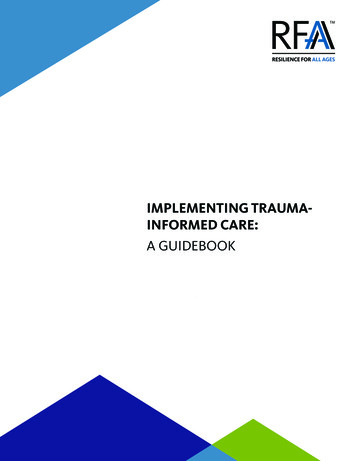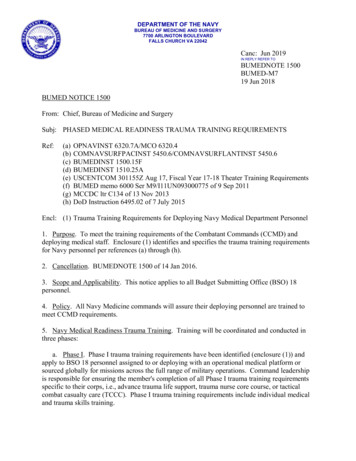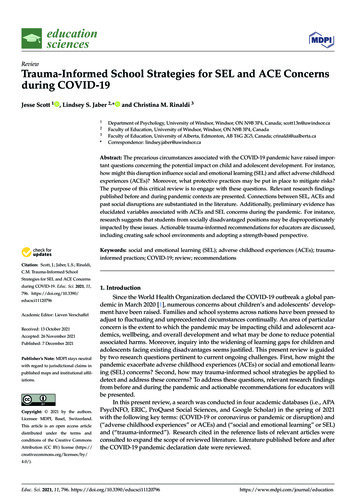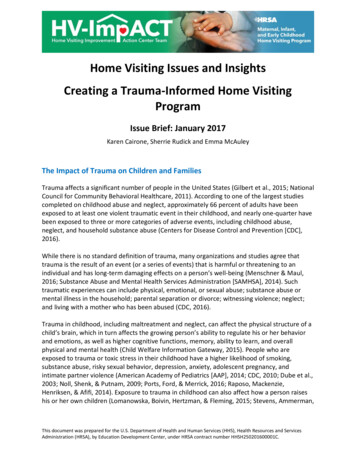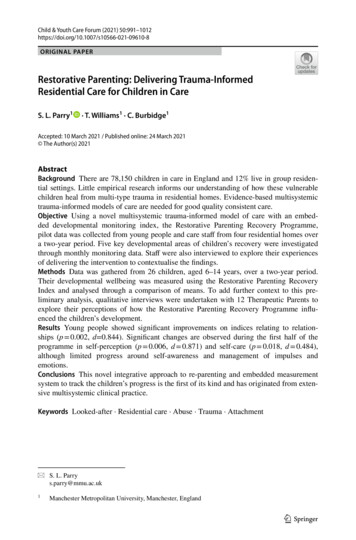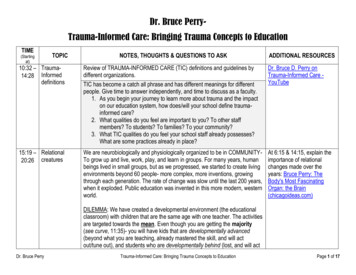
Transcription
Dr. Bruce PerryTrauma-Informed Care: Bringing Trauma Concepts to EducationTIME(Startingat)TOPICNOTES, THOUGHTS & QUESTIONS TO ASKADDITIONAL RESOURCES10:32 – Trauma14:28 InformeddefinitionsReview of TRAUMA-INFORMED CARE (TIC) definitions and guidelines bydifferent organizations.TIC has become a catch all phrase and has different meanings for differentpeople. Give time to answer independently, and time to discuss as a faculty.1. As you begin your journey to learn more about trauma and the impacton our education system, how does/will your school define traumainformed care?2. What qualities do you feel are important to you? To other staffmembers? To students? To families? To your community?3. What TIC qualities do you feel your school staff already possesses?What are some practices already in place?Dr. Bruce D. Perry onTrauma-Informed Care YouTube15:19 – Relational20:26 creaturesWe are neurobiologically and physiologically organized to be in COMMUNITYTo grow up and live, work, play, and learn in groups. For many years, humanbeings lived in small groups, but as we progressed, we started to create livingenvironments beyond 60 people- more complex, more inventions, growingthrough each generation. The rate of change was slow until the last 200 years,when it exploded. Public education was invented in this more modern, westernworld.At 6:15 & 14:15, explain theimportance of relationalchanges made over theyears: Bruce Perry: TheBody's Most FascinatingOrgan: the Brain(chicagoideas.com)DILEMMA: We have created a developmental environment (the educationalclassroom) with children that are the same age with one teacher. The activitiesare targeted towards the mean. Even though you are getting the majority(see curve, 11:35)- you will have kids that are developmentally advanced(beyond what you are teaching, already mastered the skill, and will actout/tune out), and students who are developmentally behind (lost, and will actDr. Bruce PerryTrauma-Informed Care: Bringing Trauma Concepts to EducationPage 1 of 17
TIME(Startingat)TOPICNOTES, THOUGHTS & QUESTIONS TO ASKADDITIONAL RESOURCESout/tune out)- BLACK CURVE. There will be some that come from chaos,threat, loss, and/or trauma, which all interrupt the normal developmentalprocess, and their distribution of capabilities will be further behind- REDCURVE.Looking at the graph:1. What supports is your school already providing for students across bothcurves? Lists supports independently. Regroup to discuss supports inplace.2. In an ideal classroom, what other supports are needed to meet all thestudents across both curves?3. If you could change current policies and curriculum, how would yourteaching change to meet all your students?Dr. Bruce Perry explains how20:31- Catch-up Model CHILDREN WHO START BEHIND, STAY BEHIND & TEND TO FALLFURTHER BEHIND. Of 50 children who have trouble reading in first grade, 44 ADHD can be connected to21:19childhood trauma - YouTubewill still have trouble in the fourth grade.This is true of those that are cognitively behind, as well as socially &emotionally behind- we begin to give labels- ADHD, ODD, learning disabilities.22:13 – School to22:40 Prison PipelineDr. Bruce PerryLearning about the catch-up model:1. Before hearing this statistic, had you given much thought to studentsthat are playing catch-up? Where do you think the gap is?2. What can educators do to help bridge the gap for these students?3. What can schools do to effectively address the lagging skills of thosethat are struggling in the classroom?4. How can we change the lens in which we use to stop jumping tolabels?School to Prison Pipeline begins with the inability to address impulsivity,School-to-Prison Pipelineattention problems, affect regulation problems, and poor social skills. ThisExplained – Education Equityleads to a high probability of engaging in anti-social or even criminal behaviors (eduequityforall.com)in teen years.Trauma-Informed Care: Bringing Trauma Concepts to EducationPage 2 of 17
TIME(Startingat)TOPIC23:30 – Neurobiology23:4624:37 –25:2225:23 –26:1026:15 –27:40Dr. Bruce PerryNOTES, THOUGHTS & QUESTIONS TO ASKADDITIONAL RESOURCES1. How do we change this?2. Where do we start?3. Discuss among your staff how everyone can play a part to assist thesestudents and change their trajectory.The brain is the target of our educational efforts. The more you know about thebrain, the more you will be able to create intentional and effective ways tochange the brain.Dr. Perry’s model of the brain & descriptionStress, Trauma, and theBrain: Insights for Educators-The Neurosequential Model- YouTubeFrom Dr. Perry’s work- looking at the brain activity of a 5-year-old childRed/yellow- 2 standard deviations MORE ACTIVE than a normal childDark blue- 2 standard deviations LESS ACTIVE than a normal childBruce Perry: The Body'sMost Fascinating Organ: theBrain (chicagoideas.com)If you try to teach a child with this type of brain activity, it will be significantlychallenging. This is what we see when working with children withdevelopmental trauma.Complexity of the brainTrauma-Informed Care: Bringing Trauma Concepts to EducationPage 3 of 17
TIME(Startingat)27:42 –30:4230:43 –33:2633:27 –36:10Dr. Bruce PerryTOPICNOTES, THOUGHTS & QUESTIONS TO ASKADDITIONAL RESOURCESModel of upside-downtriangle version of the brain:Bottom- Brainstem &DiencephalonMiddle- LimbicTop- Cortex- Most UNIQUEhuman part of your bodyHuge percentage of whatyou are trying to do ineducation is to get to theCORTEX and provideadequate pattern repetitive activation in key systems to allow an individualchild to learn a new vocabulary word or history or think about how toplan or learn values or beliefs of the classroom Core Regulatory Network (CRN)- originates in the lower parts of the brain;sends connections up to every part of the brain. Gets non-stop feedback fromall parts of the brain, our body, and the outside world from our senses. THEHUB and backbone of our stress response.KEY POINT: All the input from our brain and body, and the outside world,DOES NOT GO STRAIGHT TO THE CORTEX. It goes through the emotionalparts of our brain before reaching the rational part of our brain. For us tocreate an accurate memory, information MUST get to the CORTEX withsignificant accuracy.Looking at the figure above and thinking about one of your most challengingstudents:1. Can you explain the communication of some of the behaviors youwitnessed?2. Do you believe that this student was in control of those behaviors youwitnessed, or what do believe may have been a contributing factor?Trauma-Informed Care: Bringing Trauma Concepts to EducationPage 4 of 17
TIME(Startingat)TOPIC37:30 – Stress39:3139:35 –40:0740:13 –40:5941:00 –42:4142:42 –43:4243:57 –46:2246:24 –46:3446:35 –47:07Dr. Bruce PerryNOTES, THOUGHTS & QUESTIONS TO ASK3. Knowing that you must start at the bottom and work your way up, whatare some supports or strategies that you could implement to reach astudent’s cortex?Stress is ESSENTIAL for development.It is only BAD if continual or causes fatigue.Moderate stress (with some predictability and controllability) builds resilience.All of education is characterized by providing adequate doses of predictable,moderate stress.DILEMMA: When a dose of stress for one person is NOT a moderate dose ofstress for another person.Differential “State” Reactivity GraphADDITIONAL RESOURCESDr Bruce Perry The Impact ofStress On the Body YouTubeState-dependence & the Stress-reactivity Curve GraphStress Reactivity Curve GraphWhat happens under Stress? **MOST IMPORTANT POINTS**State dependent functioning- When you are in a state of CALM, your brain cando different things compared to the very same brain when it is in a state ofDISTRESS or THREAT.KEY LESSON #1: The brain under threat shuts down the cortex.KEY LESSON #2: Significant doses, significant concentrations of activatingthe stress response leads to unpredictable, extreme, prolonged activationswhich leads to vulnerability which leads to a sensitized stress response whichleads to changes in what part of the brain is on and what part of the brain isoff.Trauma-Informed Care: Bringing Trauma Concepts to EducationStress Trauma and Posttraumatic Stress Disorders inChildrenPage 5 of 17
TIME(Startingat)TOPICNOTES, THOUGHTS & QUESTIONS TO ASK50:24 –50:30Think about stress in your students.1. How many students come in “ready to learn”?2. What about your students that seemed triggered by something “sosmall”? What level of stress do you think they are coming to schoolwith?3. How do educators decrease stress at school for these students?Regulated: External Focus (CALM: ALERT)Neocortex & Limbic parts are more open; Bottom parts of the brain are notstressed, not active, not causing it to be overactive.Focusing on some new input from outside world.This child masters about 40-50% of content.Can store and retrieve information.Regulated: Internal Focus (CALM: REFLECT)Tune out others, reflecting on information, Mind wanderingDysregulated (FLOCK/FREEZE)Continues to feel threatened. As information comes into the bottom part of thebrain, it will get short-circuited and blocked, and will never get up to theCORTEX.Unable to retrieve information previously mastered when in this state (thinktest anxiety).Highly Dysregulated (FLIGHT/FIGHT)This child masters about 25% of the content.52:43 –52:52The more threatened you are, the less cortex that you have available.The major strategy for getting to the cortex is trying to help these kids getregulated.47:08 – State48:10 DependentFunction48:11 –49:1949:20 –50:23Dr. Bruce PerryTrauma-Informed Care: Bringing Trauma Concepts to EducationADDITIONAL RESOURCESThe NM Ten Tip Series:Understand Dissociation byBruce Perry, M.D., Ph.D.The NM Ten Tip Series:Understanding Hyperarousal:Page 6 of 17
TIME(Startingat)TOPIC53:26 –54:5955:22 – Learning cycle58:08 explainedNOTES, THOUGHTS & QUESTIONS TO ASKADDITIONAL RESOURCESThe average healthy human being can stay in a calm, externally alert stateThe ‘Flock, Freeze, Flight(Regulated: External Focus) for 15 seconds before they start to turn inwards and Fight’ Continuum byBruce Perry, M.D., Ph.D.and reflect on what they have been hearing (Regulated: Internal Focus).Tuning in Tuning out. The nature of learning.One of the inevitable consequences of a teaching model that expects kids toself-regulate is that the major option that they have to self-regulate is to tuneout or dissociate. They will have MANY, MANY moments when they will not belistening.Even your BEST, MOST MOTIVATED STUDENTS will have moments ofdissociation during a lecture.Reflect on Dr. Perry’s thoughts that the average healthy human being can stayin a calm, externally alert state for 15 SECONDS before they start to turninwards and reflect on what they have been hearing.1. How does this change your thoughts on instructional blocks for readingand math?2. Discuss strategies to implement within the classroom to help theseloops in learning.3. What about the students who are not in that calm state when learningbegins? How do we get them there to ensure learning occurs?You do not learn anything if you do not leave your comfort zone.Novelty activates your brain’s stress response. The brain sees everything aspotentially bad.Teaching fast or too many new concepts at one time will overwhelm the cycleand send even regulated students into a state of alarm (dysregulation), andthey may go back to a regulated dissociated state and tune out the material.FIND THE GOLDILOCKS’ SPOT- challenge enough but do not overwhelm.Dr. Bruce PerryTrauma-Informed Care: Bringing Trauma Concepts to EducationPage 7 of 17
TIMETOPIC(Startingat)NOTES, THOUGHTS & QUESTIONS TO ASKADDITIONAL RESOURCESDysregulated students can get dysregulated by the tiniest thing evenmaterial already learned and familiar with. They are OVERLY REACTIVE.58:10 –59:09For them to 1) NOT disrupt the class and 2) TO learn, we must CHANGE theslope of the curve. They must be regulated ENOUGH to get the contentthrough the brainstem.Everyone is continually getting information into the brainstem through otherparts of the brain, parts of the body and the outside world through thesenses if the person is REGULATED enough to pass the informationaccurately to the middle part of the brain, AND the person is in a relationshipthat they feel safe with, you WILL be able to get into the CORTEX to reasonwith someone so that they can REFLECT on what you said.59:15 edDr. Bruce PerryWhen dysregulated, anything that comes in from the outside world is going toget short-circuited and you are not going to learn.Reflect on the learning cycle:1. How can educators find the “goldilocks’ spot” when working with a classof students?2. Do you think educators have to change the way they teach to meet theneeds of all students?3. Does this have to be a difficult process? How can you meet studentneeds (most to all), teach material, and keep your sanity while beingthe adult in charge of a classroom?Regulate the child FIRST, which allows you to be connected, which then is thesuperhighway to the Cortex.Human beings are relational creatures. When a child feels connected with theteacher (or a parent or a coach), their cortex is open for business. If they donot feel like they belong or that the teacher doesn’t like them, is mad at them,is ignoring them, or they do not matter to the teacher, the cortex shuts down.Trauma-Informed Care: Bringing Trauma Concepts to EducationPage 8 of 17
:02:50– Change ability1:03:28 of the brain1:03:301:04:001:04:371:05:081:05:141:06:15Dr. Bruce PerryNOTES, THOUGHTS & QUESTIONS TO ASKADDITIONAL RESOURCESWe are always looking to see if we belong, if we are part of the class, group,or community. When we feel safe RELATIONALLY, the cortex is open forbusiness.IMPORTANT: Engage them in a way that makes them feel that they belong sothat they can learn.The KEY to connecting is to be regulated.1. Discuss and describe strategies that can be implemented in theclassroom to ensure that every kid feels that they belong.2. How do you build relationships? Especially with challenging students?Ways to regulate the brain (or the person):1. Self-regulatory routes2. Relational regulatory routesKEY: The neural networks in the brain are changeable. You can change theiractivity in the moment, and you can change them more chronically orpermanently.TEACHING IS: permanently changing the parts of the brain, the cognitiveparts of the brain, to LEARN.KEY: When neural activity (two patterns of activity) in the brain occurs withsufficient frequency, it creates two new synapses (creates a neural connectionby making synaptic connections).LEARNING is: Creating associations, pattern repetitive rhythmicassociations Reflect on your teaching strategies and the impact education has on the brain.1. What strategies do you currently use to ensure new synapses arecreated?2. What strategies can you begin to use to create new synapses?Trauma-Informed Care: Bringing Trauma Concepts to EducationPage 9 of 17
TIMETOPICNOTES, THOUGHTS & QUESTIONS TO ASKSelf-regulatoryroutesIf you want to alter the activity of the stress response systems (core regulatorynetwork), you must get to them:1. Activate from TOP DOWN: This is Executive Functioning- Cortexcontains the frustration that comes from being dysregulated in thebottom part of the brain. Cortex must be online and mature (whichdoes not happen until between 25 & 30 years old). CHILDREN DONOT HAVE THE TOP-DOWN REGULATORY TOOLS.2. Activate from BOTTOM UP: In utero, fetus is getting what they need tosurvive- temperature, calories- body is regulated, and not hungry,thirsty, or cold. Internally telling body that it is regulated. Also gettingthe sounds from its external world (senses)- pattern repetitive rhythmicactivity coming in. Brain makes association between this pattern,repetitive, rhythmic activity and being safe- regulated. As an infant, wecalm babies by swaying, rocking, singing, using pattern repetitiverhythmic activity.USE PATTERN, REPETITIVE, RHYTHMIC ACTIVITY IN THE CLASSROOM:start class with deep breathing or large motor activity, curve will change.Think about pattern, repetitive, rhythmic activity within your classroom.1. Are you implementing these types of activities?2. Think of some activities that would fall under this description. Sharewith the group to compare lists and add to each other’s.3. Discuss how and when to implement these types of activities.DILEMMA FOR EDUCATORS- Dosing and Spacing are two concepts that arevery important to a trauma-aware, trauma-sensitive classroom.Review Dr. Perry’s thoughts on dosing and spacing.1. How can you make changes to your lesson plans and teaching style toadequately meet the dosing and spacing requirements for yourstudents?2. Does this present any obstacles for educators? Discuss 1:12:351:13:37Dosing &SpacingDr. Bruce PerryTrauma-Informed Care: Bringing Trauma Concepts to EducationADDITIONAL RESOURCESPage 10 of 17
forms1:14:55– Regulatory1:15:37 Options1:15:411:16:53NOTES, THOUGHTS & QUESTIONS TO ASKADDITIONAL RESOURCES3. When thinking about the long-term, what do you believe the outcomeswould be if you concentrated on your dosing and spacing in yourlessons? Positive? Negative?1. Somatosensory regulation/Self-soothing2. Cortical Modulation3. DissociationDo you use somatosensory regulation/Self-soothing techniques in yourclassroom? Discuss why or why not? If yes, what benefits have youwitnessed?1. Self-regulation2. Somatosensory regulation3. Relational regulation- best & most powerful4. Pharmacological Regulation- *not recommended, except in extremecasesDo you expect students to be able to self-regulate? Why or why not?Complexities of PART OF THE DILEMMA: What we want to share is in our CORTEX asCommunication teachers, and we cannot communicate CORTEX to CORTEX.What we are trying to teach comes from our cortex through the emotional partof our brain to the dumbest part of our brain out into space in through thedumbest part of the student brain, through their emotional part of their brain totheir cortex.IF there are no distortions in us or the students, then we can effectivelycommunicate CORTEX TO CORTEX.THE TRUTH IS THERE IS ALMOST ALWAYS SOME DISTORTED FILTER.Sequential Processing of ExperienceDr. Bruce PerryTrauma-Informed Care: Bringing Trauma Concepts to EducationPage 11 of 17
TIMETOPIC(Startingat)ADDITIONAL RESOURCESAfter listening to this example, have you given thought as to how your teachingmay trigger some of your students?1:19:091:19:571:19:581:20:31NOTES, THOUGHTS & QUESTIONS TO ASKRelationalContagion1:20:321:21:43If you want to regulate a child, you MUST have a regulated teacher.Human beings are CONTAGIOUS to the mood and the behavior and theconditions of the people around them. You begin to mirror those around you.If the teacher is the dominant, regulated, calm adult in the classroom, then thatis the dominant contagion versus the dysregulated student.WE MUST TAKE CARE OF EDUCATORS: teachers need to be respected,given breaks, able to team teach, appropriate PD, well-paid, lots of respitethey can be the dominant, regulated, calm adult to help regulated thedysregulated students.The NM Ten Tip Series: TheIntimacy Barrier by BrucePerry, M.D., Ph.D.The Cost of Caring:Secondary Traumatic StressTHE CONTRAST: A dysregulated teacher WILL NOT regulate a dysregulatedchild but they may be able to dysregulate a regulated student.1. How do you keep yourself regulated during the school day? Do youhave scheduled breaks? Do you have someone that you can call?2. Discuss supports already in place, as well as some that may need to beconsidered.1:22:20- Key to a TIAn educator, respectful school- take care of your teachers and all kinds of1:22:44 Schoolincredible things will flow from that.How do you think teachers could be taken care of in your school? In yourcommunity?1:23:06- Internal State & Someone who is CALM can engage in ABSTRACT/REFLECTIVE cognition.1:26:23 What part of the When they move to an ALERT phase, they are in a CONCRETE/ROUTINEbrain isexternally focused state. Not a bad place. You must be in this state to learnavailablesomething new, and to get things into your active working memory. Then youmust move back to CALM state.Back and forth.Build in VEG time into lessons. Spacing between working and reflective time.1:21:441:22:19Dr. Bruce PerryTrauma-Informed Care: Bringing Trauma Concepts to EducationPage 12 of 17
TIMETOPIC(Startingat)NOTES, THOUGHTS & QUESTIONS TO ASKADDITIONAL RESOURCESA dysregulated child in ALARM stage is EMOTIONAL/REACTIVE. Theydevelop street smarts, but do not do well academically.IQ drops as you move from CALM to ALERT to ALARM to FEAR to tationsDr. Bruce PerryThink about how IQ drops as students move through the different internalstates (CALM - ALERT - ALARM - FEAR – TERROR).1. How can we change the way we look at some of our more challengingstudents before referring for special education testing?2. What strategies should be tried and tested before assuming that astudent’s IQ is accurate?3. When you reflect on your classrooms over the years, do you seestudents who may have been dealing with trauma and higher internalstates of stress versus having a true cognitive deficit? Knowing whatyou do now, what other strategies could have been implemented beforethe student was referred for special education testing?Example of a child’s day for a Neurotypical Student and a Sensitized Student Perry: Rhythm Regulates theBrain "Don't Try This 1. Intersperse very brief (2-3 minutes) regulatory breaks into theom)instructive hour; OR2. Link cognitive content to pattern, repetitive, rhythmic activities (poetry,hip hop, letting kids move, or any team activity) that bring relational orrhythmic activity into the cognitive part of the work. This will keep kidsmore regulated. It will keep the neurotypical kids open for businesslonger, and the sensitized kid in a state where they will not disrupt asmuch.Trauma-Informed Care: Bringing Trauma Concepts to EducationPage 13 of 17
TIMETOPIC(Startingat)NOTES, THOUGHTS & QUESTIONS TO ASKADDITIONAL RESOURCESKEY: If you have enough of the moderate, predictable stress responses, thenthe curve of the sensitized student changes. They will have more periods oftime where they will be in an engaged state.Reflect on your teaching style.1. Do you take brief breaks during instructional time?2. Do you use pattern, repetitive, rhythmic activities during instructionaltime?3. If you do, share the outcomes. If you do not, discuss activities toimplement that are age appropriate and 1:38:21More success in school, sports, and life More resilienceSensitized children come into school already above the baseline and laggingskills. if they continue the trajectory, then this is the Preschool to PrisonPipeline.IF they get an educational team to provide moderate, predictable doses ofchallenges, then they CAN change their trajectory to develop resilience.The resilience is different in Sensitized children because it comes withwisdom, pattern of post-traumatic wisdom. They develop empathy andcompassion for others, and they can reflect on where they have come.**The wisest, most potential for wisdom in your classroom may in fact be fromthe children giving you the most trouble in the moment.**Stress is important in development and resilience. Moderate, predictablestress helps students learn.Dr. Bruce PerryTrauma-Informed Care: Bringing Trauma Concepts to EducationPage 14 of 17
REFLECTION: Understanding the brain process and internal stress states of your students can help you understand thebest ways to reach them. Think about how building community and relationships in your classroom can help these students.Review your teaching style and consider some of the recommendations made by Dr. Perry. Be willing to try implementingvarious strategies to see if outcomes improve within your classroom.A BOOK STUDYTAKE IT FURTHER: ADDITIONAL RESOURCESWHAT HAPPENED TO YOU?CONVERSATIONS ON TRAUMA, RESILIENCE, AND HEALINGBY BRUCE D. PERRY, M.D., PH.D.,and OPRAH WINFREYThrough deeply personal conversations, Oprah Winfrey and renowned brain development andtrauma expert Dr. Bruce Perry discuss the impact of our pasts and how healing must begin with ashift to asking, “What happened to you?” rather than “What’s wrong with you?”YouTube Video: Oprah Winfrey & Dr. Bruce Perry in Conversation SXSW EDU 2021 - YouTubeDr. Bruce PerryTrauma-Informed Care: Bringing Trauma Concepts to EducationPage 15 of 17
VIDEOSVIDEOSAN INTERVIEWA BOOK STUDYTAKE IT FURTHER: ADDITIONAL RESOURCESTHE BOY WHO WAS A RAISED A DOGDr. Bruce PerryAND OTHER STORIES FROM A CHILD PSYCHIATRIST’S NOTEBOOK - - WHAT TRAUMATIZEDCHILDREN CAN TEACH US ABOUT LOSS, LOVE AND HEALINGBY BRUCE D. PERRY, M.D., PH.D.,with MAIA SZALAVITZIn the classic The Boy Who Was Raised as a Dog, Dr. Perry explains what happens to the brains ofchildren exposed to extreme stress and shares their lessons of courage, humanity, and hope. Onlywhen we understand the science of the mind and the power of love and nurturing, can we hope toheal the spirit of even the most wounded child.THE LONG SHADOW:BRUCE PERRY ON THE LINGERING EFFECTS OF CHILDHOOD TRAUMABY JEANNE SUPINThe SUN 4-13, NOVEMBER 2016NM NETWORK STRESS & TRAUMA SERIES 2020NINETEEN VIDEO SERIESBY THE NEUROSEQUENTIAL NETWORKSTRESS, TRAUMA, and THE BRAIN: INSIGHTS for EDUCATORS – A SERIESStress, Trauma, and the Brain: Insights for Educators--The Neurosequential Model - YouTubeStress, Trauma, and the Brain: Insights for Educators--How Stress Impacts the Brain - YouTubeStress, Trauma, and the Brain: Insights for Educators--The Power of Connection - YouTubeStress, Trauma, and the Brain: Insights for Educators--Regulating Yourself and Your Classroom - YouTubeStress, Trauma, and the Brain: Insights for Educators--Educator Strategies for the Classroom - YouTubeTrauma-Informed Care: Bringing Trauma Concepts to EducationPage 16 of 17
TAKE IT FURTHER: ADDITIONAL RESOURCESWEBSITEAUDIOHOW DOES TRAUMA AFFECT A CHILD’S BRAIN DEVELOPMENT?APRIL 30, 2018BY THE SOURCE with DR. BRUCE PERRY, DIANA OCHOA-JOHNSON, RYAN HAMILTON and MICHELLE JUSTISHAMILITONCHILD TRAUMA ACADEMY LIBRARYINCLUDES ARTICLES, VIDEOS AND AUDIOS ONWWW.CHILDTRAUMA.ORGDr. Bruce PerryINTERVENTIONS, ABUSE & NEGLECT, BRAIN DEVELOPMENT & NEUROSCIENCE, CHILD DEVELOPMENT &EARLY CHILDHOOD, TRAUMA & PTSD, VIOLENCE & PUBLIC HEALTHTrauma-Informed Care: Bringing Trauma Concepts to EducationPage 17 of 17
Bruce Perry: The Body's Most Fascinating Organ: the Brain (chicagoideas.com) 24:37 - 25:22 Dr. Perry's model of the brain & description 25:23 - 26:10 From Dr. Perry's work- looking at the brain activity of a 5-year-old child Red/yellow- 2 standard deviations MORE ACTIVE than a normal child

